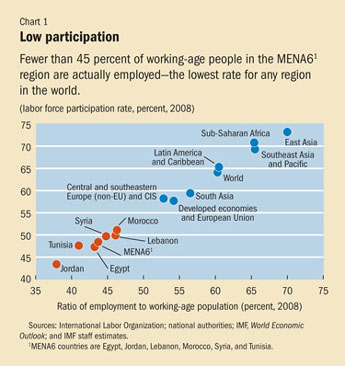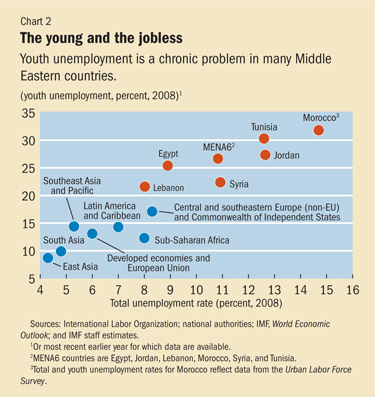Closing the Jobs Gap
Finance & Development, June 2011, Vol. 48, No. 2
Watch video: Arab Spring voices
High youth unemployment contributes to widespread unrest in the Middle East
 EVER since Tunisian street vendor Mohamed Bouazizi's death from self-immolation in January, the world's attention has been drawn to the spreading unrest in the Middle East. Bouazizi's dramatic suicide and the ensuing turmoil served as a wake-up call to policymakers, who didn't foresee such an abrupt end to the status quo.
EVER since Tunisian street vendor Mohamed Bouazizi's death from self-immolation in January, the world's attention has been drawn to the spreading unrest in the Middle East. Bouazizi's dramatic suicide and the ensuing turmoil served as a wake-up call to policymakers, who didn't foresee such an abrupt end to the status quo.
In hindsight, it's clear that many Middle Eastern societies were resting atop massive fault lines. While the unrest in these countries stemmed partly from political repression, unsustainable economic issues, such as high youth unemployment, were also simmering below the surface.
Labor market data for the region are scarce, but available statistics covering six countries—Egypt, Jordan, Lebanon, Morocco, Syria, and Tunisia—indicate that average unemployment has remained around 12 percent for the past two decades. In 2008, despite faster growth for eight consecutive years, unemployment rates for these countries averaged 11 percent, the highest regional rate in the world. And, at 48 percent, the percentage of people in the job market (the combined labor force participation rate) is much lower in these countries than in any other region.

High unemployment in these countries, together with low labor force participation rates, has resulted in very low ratios of employment to working-age population. With less than 45 percent of working-age people actually employed, this regional rate is the lowest for any region in the world (see Chart 1).
Unemployment in the region is largely a youth phenomenon. Young people, ages 15 to 24, account for 40 percent or more of the unemployed in Jordan, Lebanon, Morocco, and Tunisia, and nearly 60 percent in Syria and Egypt. The average unemployment rate among youth in these nations was 27 percent in 2008, higher than in any other region in the world (see Chart 2). In contrast to most of the world, joblessness in many Middle Eastern countries tends to increase with schooling: the unemployment rate among those with college degrees exceeds 15 percent in Egypt, Jordan, and Tunisia.

Such levels of unemployment imply substantial social and economic costs. In part because of the paucity of job prospects at home, people have left these countries in large numbers, with the estimated number of migrant workers abroad equivalent to about 16 percent of the combined labor force present in these six countries. But workers from Egypt, Jordan, Lebanon, Morocco, Syria, and Tunisia are now facing reduced prospects abroad given the sharply higher unemployment in advanced economies and a trend toward the nationalization of the labor force in the Gulf Cooperation Council countries. With greater competitive pressure from other emerging markets, the region increasingly cannot afford the status quo.
Looking ahead, the region faces a daunting challenge. To provide jobs for those now jobless as well as new entrants to the labor force, these countries have to increase employment by an estimated 18½ million full-time positions over the period 2008–20. Even this, however, would leave the ratio of employment to working-age population at about 49 percent—lower than that currently observed in any other region.
Underlying causes
Why is unemployment so persistently high in these six countries?
In part, the answer lies in demographics. Over the past decade, the combined labor force of Egypt, Jordan, Lebanon, Morocco, Syria, and Tunisia has grown at an average annual rate of 2.7 percent, faster than in any other region of the world, save Africa. The labor force growth is expected to slow gradually over the next decade, but will continue to outpace most other regions. Approximately 10 million new entrants are expected to join the labor force in the coming decade, compared with 13½ million in the previous decade. Demographic pressures, in other words, are not expected to let up anytime soon.
There is also a serious mismatch between the skills young people possess and those that firms seek. While these Middle Eastern countries are educating a growing portion of their youth, firms regularly cite the lack of suitable skills among job applicants as a constraint to hiring, and unemployment rates are highest among the most educated. This suggests that education systems are failing to produce graduates with marketable job skills.
Overly stringent hiring and firing regulations in most of the region also play a role. In Egypt, for example, severance payments for established employees (including the cost of advance notice requirements) amount to 132 weeks’ worth of their final salaries. In Syria and Morocco, these payments are equivalent to 80 weeks and 85 weeks, respectively (World Bank, 2008)—much higher than the average 38.6 weeks in the East Asia and Pacific Region and 25.8 weeks in the developed world (Dhillon and Yousef, 2009). With such a high cost of firing, firms are discouraged from hiring in the first place.
Finally, there is the problem of a bloated public sector, which lures job seekers with its greater job security, higher wages, and more generous benefits. The dominant role of the public sector as an employer in the region has distorted labor market outcomes and diverted resources from a potentially more dynamic private sector. Government hiring practices have typically inflated wage expectations and placed a premium on diplomas over actual skills, influencing education choices and contributing to skill mismatches.
Quick wins
How can governments deal with high unemployment? Any number of measures could have an immediate effect. Some of these steps would also bring long-term benefits.
Governments can
• Invest in infrastructure: Investment in infrastructure, such as transportation, water and sanitation, and energy, has the potential to generate new jobs, even in the short run. Based on evidence from Latin America and the Caribbean, Egypt could generate as many as 87,000 new jobs and Tunisia up to 18,000 in the short term by spending 1 percent of gross domestic product on infrastructure. To have an immediate effect, policymakers could put in motion labor-intensive infrastructure projects that are already in the pipeline. This strategy would not just provide employment for workers in the short term, but would also enhance the countries’ long-term growth through the benefits of the improved infrastructure.
• Support private-sector activity: To encourage job creation, policymakers could give tax incentives or provide credit guarantees to small and medium-sized enterprises that are viable and labor intensive, as was done in many emerging markets and transition economies during the global financial crisis. They could also make it easier for these firms to obtain loans.
• Scale up promising training programs: The region offers a growing range of youth-oriented training programs, such as the Education for Employment Foundation (EFE), which currently operates in several countries in the area, including Egypt, Jordan, and Morocco. EFE works with corporations and industries to assess demand for skills and provide tailored training programs for young people. Through in-class and on-the-job training, EFE has proved successful in both skills development and job placement. Policymakers should seek to scale up and replicate such programs.
• Invest in new training programs: Policymakers may want to invest in new, innovative training programs, keeping in mind that it will take time to reap the benefits. They could look to the experience of Latin American countries, where programs that are demand driven, offer on-the-job training, focus on both hard and soft skill formation, and monitor performance have improved the employment prospects and earnings of their participants.
Balancing current and future needs
When designing short-term solutions to youth unemployment, however, governments have to ensure that these policies do not hamper the long-term goals of sustainable job creation and productive skill formation.
The ongoing social and political turmoil may tempt governments to hastily create unneeded public sector jobs. Such a move, which may be difficult to reverse later, would distort labor market incentives and divert resources from the private sector. And giving subsidies to the educated unemployed youth—while well intentioned and providing short-term relief—might only serve to reinforce skills mismatches for future labor market entrants if the qualification for such subsidies is based solely on diplomas and credentials.
While governments can take steps to boost employment quickly, they should also put in place comprehensive job strategies to address the underlying causes of unemployment. These strategies would aim to foster growth that benefits all segments of society, enhance skill formation, and provide adequate social protection to workers and job seekers.
To foster inclusive growth, governments in the region have a number of options. Foremost among them is creating an environment that fosters a level playing field for everyone. People, particularly youths, should have equal opportunities to acquire a good education, compete for high-quality jobs, become entrepreneurs, access credit, and buy land. Ensuring greater equality of opportunity and broader sharing of the benefits of economic reform would lay the foundation for a sustainable improvement in living standards.
Governments can also improve the business climate. Making changes to create a business environment that is more conducive to investment and competition—including cutting red tape for business start-ups, strengthening property rights legislation, and enhancing contract enforcement—would help unlock the region’s employment potential. Improving the business climate would also help move educated young workers out of the informal sector—where they have few protections, usually earn low wages, and engage in low-growth-generating activities—and into the formal sector.
There are large numbers of expatriates from the region in Europe, the United States, and the six countries of the Gulf Cooperation Council, many of whom have advanced degrees and years of experience in competitive environments. Calling on the skilled diaspora and reversing brain drain would increase the supply of skilled labor, thereby helping domestic economies grow and compete globally. Returning members of the diaspora would bring with them their skills, capital, marketing know-how, and innovative ideas. They could open businesses and factories and hire from the pool of the unemployed. Improvements in the business environment, better governance, and better enforcement of intellectual and property rights would help bring back overseas talent, as would tax and financial incentives.
Countries in the region have been trading far below their potential. According to recent analysis by the World Economic Forum, trade policies in Egypt, Jordan, Lebanon, Morocco, Syria, and Tunisia are among the most restrictive in the world. These countries’ tariffs—averaging approximately 12 percent—are nearly double those of emerging Asia. By liberalizing external trade and opening up domestic markets, the region could boost output growth and labor demand. Lowering tariffs, diversifying trade toward fast-growing emerging markets, and increasing intraregional trade would be steps in the right direction.
Making education pay off
To address the root causes of skills mismatches, educators and governments can
• Realign curricula with private-sector needs: Policymakers can scale up initiatives that better equip students with skills and knowledge required by the private sector. One such initiative is Injaz, a partnership between ministries of education and the private sector that gets business leaders to teach marketable skills to high school and college students, including basic business skills, teamwork, leadership skills, and entrepreneurial thinking. Injaz was launched in Jordan in 1999, but has now spread to a dozen countries.
• Change university admission policies: Universities' admissions policies could influence skill formation at lower levels of education by making it mandatory for prospective college students to exhibit skills such as writing, critical thinking, and problem solving. Those requirements would give incentives to parents, educators, and students to go beyond rote learning at the primary and secondary levels.
• Reform public sector hiring practices and compensation policies: Public sector hiring should place more emphasis on skills and competition and less on paper qualifications. Governments could introduce interviews and tests that evaluate a range of skills beyond what is currently being tested. Moreover, strengthening the link between compensation and performance and implementing merit-based promotion policies would also give young people greater incentives to form the right skills (Salehi-Isfahani and Dhillon, 2008).
Any long-term jobs strategy should promote worker protection while at the same time preserving labor market flexibility—a feature that is ultimately in the worker’s interest.
The region’s overly rigid labor rules (such as large severance packages), while intended to protect employees, actually impede job creation in the formal sector and end up driving firms into the informal economy. Policymakers should aim to relax these regulations while preserving the right to collective bargaining and providing effective social protections, including unemployment insurance, for workers and job seekers. Relaxing labor market regulations would enable the private sector to respond more flexibly to market signals and increase the employment response of other reforms, such as trade liberalization.
Much can be done to improve the currently dismal employment prospects of young people in the Middle East. Short-term actions are desirable, given the urgent need to satisfy the legitimate demands of the region’s youth. But such measures are no substitute for a comprehensive long-term employment strategy that reorients education, improves the business climate, and dismantles the obstacles that prevent firms from hiring. ■
References
Dhillon, Navtej, and Tarik Yousef (eds.), 2009, Generation in Waiting: The Unfulfilled Promise of Young People in the Middle East (Washington: Brookings Institution Press).
Noland, Marcus and Howard Pack, 2007, The Arab Economies in a Changing World (Washington: Peterson Institute for International Economics).
Salehi-Isfahani, Djavad, and Navtej Dhillon, 2008, “Stalled Youth Transitions in the Middle East: A Framework for Policy Reform,” Middle East Youth Initiative Working Paper.



